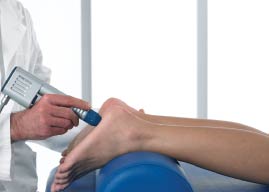Bunions
A bunion is a prominence or bony growth, on the side of the foot by the big toe. Both pressure from your shoes and motion in the big toe joint can cause pain. Bunions can often progress gradually until running and sometimes even walking are extremely painful.
Causes: A bunion is a condition that can be due to heredity, a genetic defect or a biomechanical problem (over-pronation). People with flat feet or very flexible feet are more prone to develop bunion problems. Other causes can include such things as trauma, arthritis or neuromuscular diseases. Tight-fitting shoes do not cause bunions, but they can exaggerate either of these pre-existing conditions.
Symptoms: The severity of the bunion does not necessarily correlate with the degree of pain. A bunion that looks severe may not be painful at all, whereas a small or mild bunion can sometimes be extremely painful or debilitating.
Pain can usually develop for one of two reasons: Either over the prominence due to friction irritation from the inside of the shoe, or due to the mal-alignment of the big toe joint. Both of these sources of discomfort may, over time, limit walking, exercise or even standing comfortably.
If the joint has been in a mal-aligned position for many years, osteoarthritis can develop, which can lead to increased stiffness and pain within the joint.
Bunions can also affect the other adjacent toes. If the big toes starts to lean outwards, the increased pressure on the second toe may cause it to be pushed upwards, leading to a hammertoe deformity and often an associated callous on the bottom of the foot.
Treatment: If the symptoms are mild to moderate, the easiest and solution to try is to wear a pad over the bunion to reduce friction on the inside of your shoes. A wider, more accommodating shoe, often with a deep toe box, can also be very helpful. If your podiatrist thinks over-pronation is the cause, and the bunion is in the early stages, try a custom orthotic. This will reduce the excessive pronation and attempt to minimize the future growth of the bunion. Anti-inflammatory mediations can often provide temporary relief.
When the bunion pain is persistent, despite trying various conservative treatment options, surgical correction should be discussed with your podiatrist. In a symptomatic foot, the longer that surgery is delayed, the more arthritis can wear on the joint, and often the more complicated the surgery can become. Those patients that have their symptomatic bunions corrected earlier tend to have greater satisfaction after the procedure.



